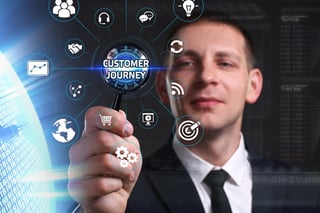 Think back to a customer you acquired six months ago. How much do you know about them? What attracted them to your services? Why do they continue to rely on you?
Think back to a customer you acquired six months ago. How much do you know about them? What attracted them to your services? Why do they continue to rely on you?
The answer to the last question is vital, because any MSP will tell you customer retention leads to recurring revenue. And answers to all of the questions would be common knowledge if you have a thoroughly mapped out customer journey. Read on for advice to create your own, and how to use it to uncover additional MSP sales opportunities.
Stages of the customer journey
So, what is a customer journey? Put yourself in your customers’ shoes for a moment and imagine the entirety of their interaction with your organization – from the initial web search to talking up your incredible service to their peers. That’s the basis of a journey map.
Companies all over the world are using them to understand their customers’ motivations and find more impactful ways of engaging with them at various points in their sales funnel. And the same approach can be applied to your MSP sales funnel.
Though every company seems to do theirs a little differently, most customer journeys include the following stages:
Awareness
A potential customer understands they have a need and researches solution alternatives – including your organization.
Consideration
He/she weighs the available options to help inform his/her buying choice.
Purchase
A decision is made, and your goods or services are paid for.
Retention
Your service or product quality and exceptional aftercare keeps the customer engaged and spending with your company.
Advocacy
He/she is so delighted with the goods or services they promote it to their peers – leading to word of mouth promotion.
Some organizations may refer to these stages by different names, but the linear structure of a customer’s interaction with their product or service likely mirrors this frame. More differences arise when they map out who takes the journey.
Who’s taking the journey?
Even if you’re offering a single product or service, different customers are going to need different things from you to feel satisfied with their purchase. A thorough journey map includes all the possible customer touchpoints which keep them moving along your MSP sales funnel. But how a customer travels through it depends on the type of customer they are. This is where buyer personas come into play.
Buyer personas assist you with segmenting common customer varieties to better understand how the journey varies for their personal needs. In this sample persona we see a full characterization of Steve. This is a terrific persona because we gain insight into his place as a decision maker, as well as his needs, feelings and potential barriers that may challenge a sale closing.
Take a moment to think about your common customer types. What initially attracts them to your service? What do they need your service to solve? What are their opinions about the work your organization performs? What objections have you heard in the past?
Some answers may come from your recurring exposure to the same customer type. However, the best buyer personas are ones drawn from firsthand research and discussion. The more of these details you can get from the customers’ mouths, the more authentic and relevant your touchpoints along the journey become.
Crafting your own customer journey map
Beyond firsthand research of your buyer types, the most critical element for mapping your customer journeys is to build them from their point of view. From Tandem Seven’s post 5 Essential Components of Effective Customer Journey Maps, “Rather than thinking of the stages and steps of the journey from a systems or business process perspective, the journey is based on what the customer does. This extends to what they think and how they feel, as they interact with your brand across multiple touchpoints and/or relationship stages.”
Get behind their desks (metaphorically) and into their minds! If you can determine your customers’ perceptions of their experience relative to their goals from a solution, overall needs, and expectations, then your journey will increase in appeal. This naturally feeds the top of the funnel with new prospects, and provides more opportunities to convert further down the MSP sales pipe.
Additionally, it’s wise to map out both their current and future journeys across multiple touchpoints. From an organizational perspective, this exercise will help you evaluate trouble spots in your present funnel. It may also inspire changes that improve the overall experience for new buyers.
Be sure to include performance indicators to gauge effectiveness. And lastly, make it visual. Writing out a journey would be arduous for its authors and readers alike. Visualizing your map is more efficient, more direct, and easier to reference by those who weren’t involved in its construction.
Applying the customer journey to your sales strategy
Every stage of the journey presents an opportunity for your sales strategy.
Awareness
As you attract more and more potential customers, you’re increasing the volume at the top of the funnel.
Consideration
While potential customers consider your offering, you’re increasing the perceived value of the service you provide.
Purchase
Do you hear the cash register ringing in the background? Conversions equal revenue!
Retention
After the initial purchase, what you do to foster your relationship with the customer – whether it’s offering add-on services, partnering closely with their IT team, or sending out simple satisfaction surveys – improves the odds of repeat business and uncovering other possible revenue sources.
Advocacy
As your satisfied customers sing your praises to their peers, you’re creating a free (and trusted) advertising source that could feed the top of your funnel with more potential buyers.
Unlocking these benefits to your sales strategy depends on the thoroughness of your buyer persona development, as well as how deeply you can get in their shoes to walk through his/her customer journey.
It takes a lot of work. Seriously - a lot! But the revenue gains from such intense effort, as any organization using this method can attest, is invaluable. You’ll gain a clear view of how potential and current customers interact with your service - which may lead to sales. Which may also lead to discovering why customers in the past went with a competitor; inspiring you to strategize improvements to your offering.








